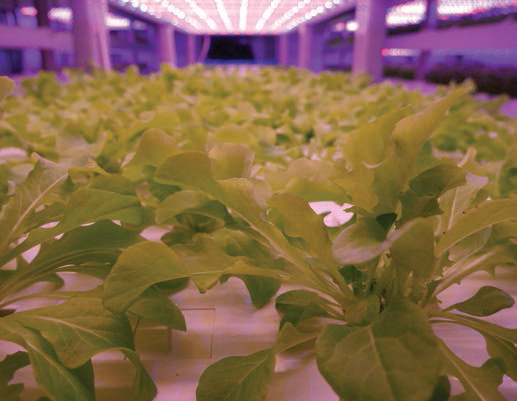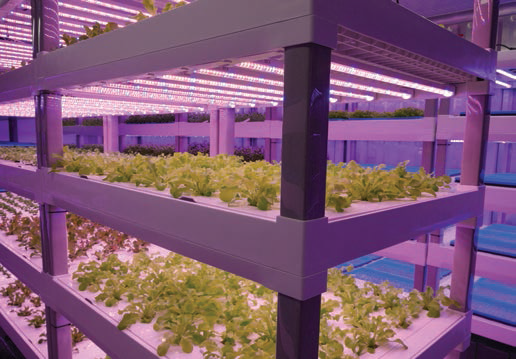 John Paul Prior asks will vertical farming mean that Irish horticulture finally gets its ‘day in the sun’?
John Paul Prior asks will vertical farming mean that Irish horticulture finally gets its ‘day in the sun’?
As our climate continues to change, and populations across the globe expand, food production is evolving in order to keep pace with such unprecedented changes. Through technological advances, Irish Horticulture may finally have it’s ‘day in the sun’, as Irish producers consider the benefits of growing many months of the year, without it.
Growing hyper-locally, 365-days a year, pesticide-free and replacing some of the €300 million in imported fresh produce that is shipped and flown into our country annually, makes thinking “inside the box” a worthwhile consideration for any Irish farmer who’s interested in supplementing their current growing business or supporting diversification 

WHAT IS VERTICAL FARMING?
Vertical farming involves growing crops in vertical layers and most often within a controlled environment and under a specially configured low energy, LED grow lighting spectrum, which aims to optimise the conditions for optimal plant growth and nutrition. Vertical farming enables more harvests throughout the year and since these harvests are not climate-related, they can be achieved all year-round.


Over the past two decades, in particular, there have been significant improvements in efficiencies of this technology, much of which was developed and honed by cannabis producers, who learned how to grow plants at scale under lights through hydroponic systems. Now, it’s one of the fastest-growing sectors in lighting, with the grow lighting market valued at USD $2.50 billion in 2016 and expected to reach USD $5.11 billion by 2022.
While advances in the efficiencies of grow lighting is relatively recent, the associated growing method used in vertical farms – hydroponics – is nothing new. In fact, the first known instance of water-based hydroponics is in the Hanging Gardens of Babylon, one of the Seven Wonders of the Ancient World. The gardens thrived off an elaborate watering system that supplied a steady stream of river water, rich in oxygen and minerals.
In hydroponic systems, the roots of plants are submerged in liquid solutions containing macronutrients, such as nitrogen, phosphorus, sulphur, potassium, calcium and magnesium, as well as trace elements, including iron, chlorine, manganese, boron, zinc, copper and molybdenum.
VERTICAL FARMING AND THE FARM-TO-FORK SUPPLY CHAIN
The country has nowhere near the output required to deal with the current demands of Irish consumers in relation to leafy greens. Dietary trends are ensuring that this demand is likely to increase considerably in the coming years. ‘Farm to Fork’ and ‘Farm to table’ are now commonly used terms to emphasise the required reduction in food miles through the supply chain. From a supply chain standpoint, there are two major benefits to vertical farming:
1. Vertical farms can reduce the number of miles vegetables must travel in order to reach supermarket shelves.
2. Reduces fuel consumption, driving down the total cost to consumers.
SUSTAINABLE AGRICULTURE
With sustainability a top concern for Irish consumers and producers alike, vertical farming can play a significant role in the future of sustainable agriculture. As a result of the recirculation of water throughout multiple growing cycles, vertical farms use up to 95% less water than traditional farms. Through the use of an OR (reverse osmosis) system, this figure can be reduced even further.
Additionally, given their highly-controlled structures, pesticides and herbicides are not needed to thwart would-be pests. A vertical farm can grow a larger variety of crops at once because crops do not share the same plots of land. In addition, due to its relatively small footprint, vertical farming is also less disruptive to the native plants and animals, leading to further conservation of the local flora and fauna.
As I write this piece, Ireland has experienced more than twice the normal amount of rainfall per day during the first 16 days of February, according to official precipitation figures published on the Met Éireann website. Flood warnings are in place throughout the midlands along the River Shannon. As a result of these increasingly unpredictable changes in our climate, flooding of land and polytunnels is becoming a more frequent occurrence. Through Controlled Environment Farming, this destructive impact can be avoided completely. Vertical farms have no spoilage due to such inclement weather conditions, while the output can be programmed directly in line with demand which enables optimised production.
PHOTOBIOLOGY AND SPECTRAL RESEARCH
Photobiology is an area of science that studies the interactions of light on living organisms. Sananbio is a US company whose core focus is the optimisation of lighting spectrums that allow plants to thrive at all stages of growth. Following years of scientific research, through the latest developments in LED lighting technology, Sananbio is working to understand the synergy that exists between artificial light and plants.
Traditional farming is a critical requirement in the local food supply, and local food supply is critical in ensuring our population has access to the most nutritious, fresh produce. The Irish climate is limiting us to a growing season for leafy green veg of May to September. This climate is also becoming less predictable. Outside of these months, we currently import, and in staggering numbers. Controlled Environment Vertical Farming can be supplementary and complementary, and can replace the vast majority of these imports while creating local jobs and local supply for our communities. Therefore ensuring our food security for the future. It can inspire a new generation of Irish grower, enthused by greater technology input.
The Irish population continues to grow, and as more and more emphasis is put on environmental sustainability, vertical farming can help to fill that void. Vertical farms have shown the ability to eliminate foodborne illness outbreaks (especially E. coli), maximise crop yields, and reduce water consumption. From a supply chain standpoint, vertical farms are reducing the miles on our fresh produce as well as getting it on our shelves faster. Vertical farms can be located in previously disused farm buildings, in repurposed shipping containers, in mushroom houses. They can be the cornerstone of urban and rural renewal alike. Certainly worth consideration. ✽
  |







